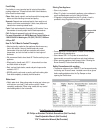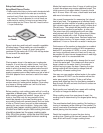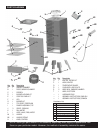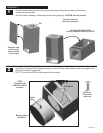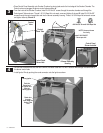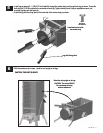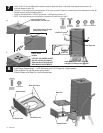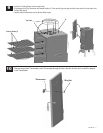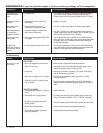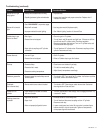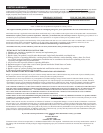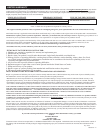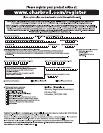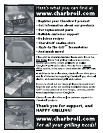Special offers from our partners!

Find Replacement BBQ Parts for 20,308 Models. Repair your BBQ today.

18 • 10201597-50
EMERGENCIES: If a gas leak cannot be stopped, or a fire occurs due to gas leakage, call the fire department.
Emergencies
Problem
Gas leaking from
cracked/cut/burned
hose.
Gas leaking from LP
cylinder.
Gas leaking from LP
cylinder valve.
Gas leaking between
LP cylinder and
regulator connection.
Fire coming through
control panel.
Grease fire or
continuous excessive
flames above cooking
surface.
Burner will not light
using ignitor.
Possible Cause
Possible Cause
• Damaged hose.
• Mechanical failure due to rusting or
mishandling.
• Failure of cylinder valve from
mishandling or mechanical failure.
• Improper installation, connection not
tight, failure of rubber seal.
• Fire in burner tube section of burner due
to blockage.
• Too much grease buildup in burner area.
GAS ISSUES:
• Burner not engaged with control valve.
• Obstruction in burner.
• No gas flow.
• Vapor lock at coupling nut to LP cylinder.
• Coupling nut and LP cylinder valve not
fully connected.
ELECTRICAL ISSUES:
• Electrode cracked or broken; “sparks at
crack.”
• Electrode tip not in proper position
• Wire and/or electrode covered with
cooking residue.
• Wire is loose or disconnected.
• Wire is shorting (sparking) between
ignitor and electrode.
Prevention/Solution
Prevention/Solution
• Turn off gas at LP cylinder or at source on natural gas systems. If
hose is cut or cracked, replace valve/hose/regulator. See LP
Cylinder Leak Test and Connecting Regulator to the LP Cylinder.
• Replace LP cylinder.
• Turn off LP cylinder valve. Return LP cylinder to gas supplier.
• Turn off LP cylinder valve. Remove regulator from cylinder and
visually inspect rubber seal for damage. See LP Cylinder Leak Test
and Connecting Regulator to the LP Cylinder.
• Turn off control knob and LP cylinder valve. Allow flames to die
down. After fire is out and fryer is cold, remove burner and inspect
for spider nests or rust. See Natural Hazard and Cleaning the
Burner Assembly pages.
• Turn off control knobs and LP cylinder valve. Allow flames to die
down. After cooling, clean food particles and excess grease from
inside fryer body, grease tray, and other surfaces.
• Make sure valve is positioned inside of burner tube.
• Ensure burner tube is not obstructed with spider webs or other
matter. See cleaning section of Use and Care.
• Make sure LP cylinder is not empty. If LP cylinder is not empty,
refer to “Sudden drop in gas flow.”
• Turn off knob and disconnect coupling nut from LP cylinder.
Reconnect and retry.
• Turn the coupling nut approximately one-half to three-quarters
additional turn until solid stop. Tighten by hand only - do not use
tools.
• Replace electrode.
• Tip of electrode should be pointing toward gas port opening on
burner. The distance should be 1/8” to 1/4”. Adjust if necessary.
• Clean wire and/or electrode with rubbing alcohol and clean swab.
• Reconnect wire or replace electrode/wire assembly.
• Replace ignitor wire/electrode assembly.
Troubleshooting




